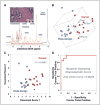Metabolomic imaging of prostate cancer with magnetic resonance spectroscopy and mass spectrometry
- PMID: 23549758
- PMCID: PMC3690591
- DOI: 10.1007/s00259-013-2379-x
Metabolomic imaging of prostate cancer with magnetic resonance spectroscopy and mass spectrometry
Abstract
Metabolomic imaging of prostate cancer (PCa) aims to improve in vivo imaging capability so that PCa tumors can be localized noninvasively to guide biopsy and evaluated for aggressiveness prior to prostatectomy, as well as to assess and monitor PCa growth in patients with asymptomatic PCa newly diagnosed by biopsy. Metabolomics studies global variations of metabolites with which malignancy conditions can be evaluated by profiling the entire measurable metabolome, instead of focusing only on certain metabolites or isolated metabolic pathways. At present, PCa metabolomics is mainly studied by magnetic resonance spectroscopy (MRS) and mass spectrometry (MS). With MRS imaging, the anatomic image, obtained from magnetic resonance imaging, is mapped with values of disease condition-specific metabolomic profiles calculated from MRS of each location. For example, imaging of removed whole prostates has demonstrated the ability of metabolomic profiles to differentiate cancerous foci from histologically benign regions. Additionally, MS metabolomic imaging of prostate biopsies has uncovered metabolomic expression patterns that could discriminate between PCa and benign tissue. Metabolomic imaging offers the potential to identify cancer lesions to guide prostate biopsy and evaluate PCa aggressiveness noninvasively in vivo, or ex vivo to increase the power of pathology analysis. Potentially, this imaging ability could be applied not only to PCa, but also to different tissues and organs to evaluate other human malignancies and metabolic diseases.
Conflict of interest statement
Figures








References
-
- NCI. Defeating Prostate Cancer: Crucial Directions for Research, Report of the Prostate Cancer Progress Review Group. 1998. - PubMed
-
- Siegel R, Naishadham D, Jemal A. Cancer statistics, 2012. CA Cancer J Clin. 2012;62:10–29. - PubMed
-
- Andriole GL, Crawford ED, Grubb RL, 3rd, Buys SS, Chia D, Church TR, Fouad MN, Gelmann EP, Kvale PA, Reding DJ, Weissfeld JL, Yokochi LA, O’Brien B, Clapp JD, Rathmell JM, Riley TL, Hayes RB, Kramer BS, Izmirlian G, Miller AB, Pinsky PF, Prorok PC, Gohagan JK, Berg CD. Mortality results from a randomized prostate-cancer screening trial. N Engl J Med. 2009;360:1310–9. - PMC - PubMed
-
- Brawer MK. Prostate-specific antigen: current status. CA Cancer J Clin. 1999;49:264–81. - PubMed
Publication types
MeSH terms
Grants and funding
LinkOut - more resources
Full Text Sources
Other Literature Sources
Medical

